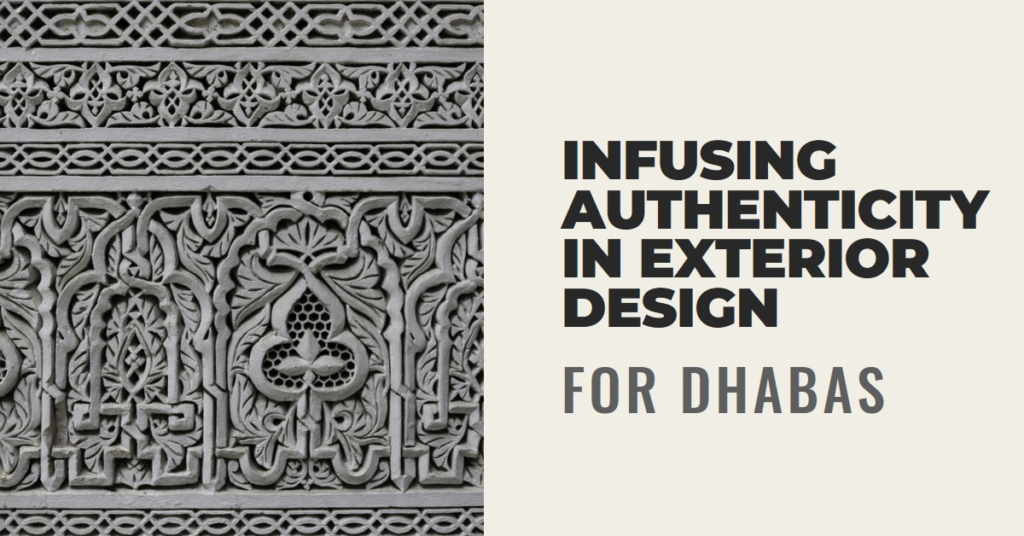
Table of Contents
Introduction:
Dhabas, traditional roadside eateries in South Asia, are not just places to eat; they are cultural landmarks that reflect the region’s rich heritage. Authenticity in their exterior design involves preserving and celebrating these cultural nuances. From the vibrant colors of Punjab to the rustic simplicity of rural Bengal, each dhaba tells a unique story through its architecture and decor.
Authenticity begins with a deep understanding of local traditions and architectural styles. For instance, in Punjab, dhabas often feature bold colors like deep oranges and yellows, inspired by the region’s agricultural roots and warm hospitality. In contrast, dhabas in Rajasthan might showcase intricate Rajputana designs and desert-inspired motifs. By embracing these cultural elements, designers can create spaces that resonate with both locals and visitors alike.
Integrating Traditional Materials and Techniques:
One of the hallmarks of authentic dhaba design is the use of traditional materials and construction techniques. Mud plastered walls, thatched roofs, and locally sourced timber not only add to the aesthetic appeal but also ensure sustainability and environmental harmony. These materials not only blend seamlessly with the surroundings but also contribute to the authentic rustic charm that dhabas are known for.
Incorporating traditional techniques such as handcrafted pottery, terracotta tiles, and intricate wood carvings further enhances the authenticity of the exterior design. These elements not only pay homage to local craftsmanship but also create a sensory experience that transports patrons to a bygone era of simplicity and artisanal excellence.
Harmonizing with Natural Surroundings:
Authentic dhaba design goes beyond aesthetics; it harmonizes with its natural surroundings. Whether nestled amidst lush greenery, overlooking a serene river, or set against the backdrop of majestic mountains, dhabas are designed to complement and blend with the landscape. This integration not only enhances the visual appeal but also fosters a sense of tranquility and peace for diners.
Architects and designers often leverage natural elements such as stone, bamboo, and even recycled materials to ensure that dhabas remain eco-friendly and visually appealing. By using these materials, designers not only reduce the environmental footprint but also create spaces that resonate with the local ecosystem and climate, ensuring sustainability in design.
Creating Inviting Entryways and Facades:
The exterior facade and entryway of a dhaba play a crucial role in welcoming guests and setting the tone for their dining experience. Authenticity here lies in the meticulous attention to detail, from hand-painted signage to intricately carved doorways. These elements not only attract passersby but also evoke a sense of curiosity and anticipation.
Designers often use vibrant colors, traditional motifs, and locally inspired artwork to adorn the facades. Murals depicting local folklore, ornamental ironwork, and even hanging brass bells add a touch of whimsy and charm. By incorporating these elements, dhabas not only stand out visually but also become integral parts of the community, fostering a sense of pride and identity among locals.
Enhancing Dining Spaces with Outdoor Seating:
Outdoor seating areas in dhabas are extensions of their authentic charm, offering diners a chance to immerse themselves in the natural beauty and local ambiance. From simple wooden benches under shady trees to elaborate bamboo pergolas adorned with colorful textiles, these spaces are designed to maximize comfort while celebrating the outdoors.
Designers often integrate elements like traditional chatai mats, handmade cushions, and ambient lighting to create cozy and inviting dining environments. By blending comfort with cultural aesthetics, outdoor seating areas become popular gathering spots where friends and families can enjoy hearty meals amidst scenic surroundings.


Innovating with Modern Amenities Without Compromising Authenticity:
While traditional dhabas exude old-world charm, modern amenities are crucial for enhancing customer experience without compromising authenticity. Designers often integrate solar panels for energy efficiency, eco-friendly plumbing systems, and even Wi-Fi connectivity while maintaining the rustic appeal of the exterior design.
Innovations such as modular kitchens, efficient waste management systems, and sustainable landscaping techniques not only cater to modern expectations but also uphold the cultural integrity of dhabas. By striking this balance between tradition and innovation, designers ensure that these eateries remain relevant and appealing to a diverse clientele.
Incorporating Local Art and Craftsmanship:
Art and craftsmanship are integral to the authenticity of dhaba design. Local artisans play a pivotal role in creating bespoke artworks, from hand-painted murals depicting local folklore to intricate wood carvings and pottery. These artworks not only beautify the space but also preserve and promote indigenous cultural heritage.
Designers collaborate closely with artisans to create customized pieces that reflect the spirit and identity of the region. By showcasing these artworks prominently in the exterior design, dhabas become cultural hubs where art, food, and community converge, fostering a deeper appreciation for local traditions among visitors and locals alike.
Sustainability Practices in Exterior Design:
Sustainability is increasingly becoming a cornerstone of authentic dhaba design. Designers prioritize eco-friendly practices such as rainwater harvesting, native landscaping, and passive cooling techniques to reduce environmental impact and promote long-term sustainability. These practices not only benefit the environment but also resonate with the values of conscientious diners.
By incorporating sustainable materials like bamboo, reclaimed wood, and natural finishes, designers create dhabas that are not only visually appealing but also contribute positively to the local ecosystem. This commitment to sustainability ensures that dhabas remain integral parts of their communities for generations to come.
Conclusion: Preserving Heritage Through Responsible Design
Preserving heritage through responsible design is paramount in maintaining the authenticity of dhabas. Designers collaborate with local communities and heritage conservationists to safeguard historical structures, traditional craftsmanship, and cultural practices. By adopting adaptive reuse techniques and restoration methods, dhabas retain their original charm while adapting to contemporary needs.
Responsible design also involves educating patrons about the cultural significance of dhabas and the importance of preserving heritage sites. Through guided tours, interactive displays, and storytelling sessions, dhabas become platforms for cultural exchange and awareness, bridging the gap between the past and the present.


